The X Button
Idol Talk
by Todd Ciolek,
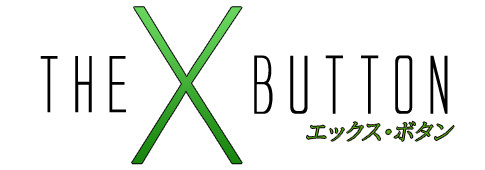
I'll start this week's X Button with something that's always big news to me, no matter what others say. Of course, I refer to the introduction of yet another character in yet another Final Fantasy game.
The boomerang-wielding 14-year-old named Hope Estheim actually showed up in Final Fantasy XIII's E3 trailer, but it was only recently that producers revealed his name and backstory: he's a l'Cie, a human marked with a brand and a strange destiny by godlike creatures known as fal'Cie (Get it? FAL-SIE? Oh, Square!). Seeking revenge for the death of his mother, Hope joins up with the group containing the rest of the game's playable cast so far: Lightning, Snow, Vanille, Sazh, and the chocobo that lives inside Sazh's hair. The twist? Hope blames his mom's untimely demise on Snow, and those who've seen the Final Fantasy XIII demo will know why.
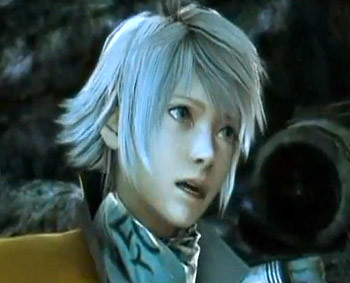
I was hoping that Final Fantasy XIII would avoid sticking some barely teenage boy among its main characters. Sure, Final Fantasy might be made for 14-year-olds, but a blond kid with tragic motivation is the biggest cliché in the series at this point. At least Final Fantasy XII had the sense to gradually make its teenage hero into an often irrelevant supporter of more vital characters. I'd like to see Final Fantasy go further down XII's path and get away from the same anime-industry archetypes, though I doubt that'll happen with Final Fantasy XIII. His name is Hope Estheim, after all.
NEWS
SHIN MEGAMI TENSEI GOES DUNGEON HACKING
As much as Final Fantasy introduces spin-offs, I wonder if the Shin Megami Tensei series will surpass it before long. Strange Journey is the latest Shin Megami Tensei game, a dungeon-crawler focused on exploring a rift in the skies above Antarctica. Since this is a Shin Megami Tensei game, that rift leads to a world of demonic creatures and twisted passages, all shown from a first-person perspective. Upon naming your soldier, you strike out into this strange dimension alongside an international selection of researchers and military specialists. Curiously, there doesn't seem to be a Japanese high-schooler among them.

Other Shin Megami Tensei games use a first-person perspective for navigating enemy-filled environments, but Strange Journey is clearly drawing from the recent spate of grueling, businesslike dungeon hacks like Etrian Odyssey and The Dark Spire. Hallways are shown in the upper DS screen, while your attacks and enemy actions are rattled off in text as the enemies float before you. Enticing demons to join your party also figures into battles, as it often does in Shin Megami Tensei games, and Strange Journey adds a character-upgrading system involving the environmental suits needed in such a harsh world.
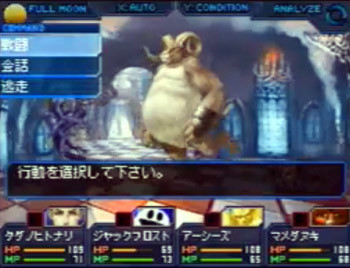
Strange Journey sets an interesting stage for a dungeon crawl, no matter how much it sounds like a Sci Fi Channel (sorry, Sy Fy) original movie. Most Shin Megami Tensei games send monsters crawling through Japanese cities and towns, so it'll be a pleasant change to trek through completely alien corridors filled with the hideous creations of artist Kazuma Kaneko. It'll be out in Japan this October, with an American release very, very likely.
MILES EDGEWORTH IN 2010
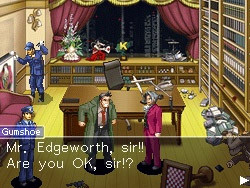 Comic-Con prompted a new trailer and a February 2010 release date for the latest Phoenix Wright game, Ace Attorney - Investigations, which is actually all about prosecutor Miles Edgeworth. CAPCOM's trailer for the English version shows the cravat-sporting Edgeworth dissecting crime scenes with detective Dick Gumshoe, who apparently needs lessons in deductive reasoning. Edgeworth also plays straight man to his new sidekick, the over-enthusiastic thief Kay Faraday, as she fills much the same role that Maya Fey did in older Phoenix Wright games. It remains doubtful that CAPCOM will have anything quite as nice as the huge bonus pack that shipped with the Japanese version of Edgeworth's game, though maybe they'll toss in the business card holder for people who reserve it somewhere.
Comic-Con prompted a new trailer and a February 2010 release date for the latest Phoenix Wright game, Ace Attorney - Investigations, which is actually all about prosecutor Miles Edgeworth. CAPCOM's trailer for the English version shows the cravat-sporting Edgeworth dissecting crime scenes with detective Dick Gumshoe, who apparently needs lessons in deductive reasoning. Edgeworth also plays straight man to his new sidekick, the over-enthusiastic thief Kay Faraday, as she fills much the same role that Maya Fey did in older Phoenix Wright games. It remains doubtful that CAPCOM will have anything quite as nice as the huge bonus pack that shipped with the Japanese version of Edgeworth's game, though maybe they'll toss in the business card holder for people who reserve it somewhere.
YGGDRA UNISON HEADS TO THE DS
 Sting's Yggdra Union: We'll Never Fight Alone brought its cute characters and complex strategy-RPG battles to both the Game Boy Advance and PSP, but the DS was oddly skipped. Well, Yggdra Union isn't coming to the system, but its cell-phone retelling, Yggdra Unison: Beat Out Our Obstacle, will show up on the Japanese DS this December. Not technically a sequel, Yggdra Unison spins a new story about Princess Yggdra in an alternate world, one where her path to glory or defeat doesn't play out as it did in Yggdra Union.
Sting's Yggdra Union: We'll Never Fight Alone brought its cute characters and complex strategy-RPG battles to both the Game Boy Advance and PSP, but the DS was oddly skipped. Well, Yggdra Union isn't coming to the system, but its cell-phone retelling, Yggdra Unison: Beat Out Our Obstacle, will show up on the Japanese DS this December. Not technically a sequel, Yggdra Unison spins a new story about Princess Yggdra in an alternate world, one where her path to glory or defeat doesn't play out as it did in Yggdra Union.
The gameplay of Yggdra Unison retains the original's strategy-RPG focus, with characters moving about maps and bashing each other in side-view combat. It looks a lot better on the DS, though, and having it on a wider screen will certainly benefit the overall strategy. The DS version is also a good candidate for the North American market, since Atlus released both editions of Yggdra Union over here.
IN BRIEF: BROKEN DESTINY IN SEPTEMBER, NARUTO 5 IN EUROPE
Well, that's fast. Soul Calibur: Broken Destiny, a PSP adaptation of Soul Calibur IV, is coming out in the U.S. on September 1. Quite prompt of Namco Bandai, though it suggests we won't see any more new characters. It'll just be Dampierre and God of War's Kratos joining the established Soul Calibur cast, though I imagine Kratos alone will bring in some new fans.
Namco Bandai's Naruto games helped prop up the North American PlayStation 2 in recent years, though the latest, Naruto Shippūden: Ultimate Ninja 5, might be the last for the system. In fact, Namco Bandai hasn't officially announced a U.S. release yet; at this writing, it's just confirmed for Europe. CyberConnect 2's 60-ninja game should find its way here eventually, since there's no reason to waste that localization.
WEIRD-ASS IMPORT ROUNDUP: JULY
BLAZING SOULS ACCELATE
 Developer: Idea Factory
Developer: Idea Factory
Publisher: Idea Factory
Platform: PSP
Players: 1
Had it not been for Nippon Ichi's Disgaea, Idea Factory's loosely linked Neverland series would still be exclusive to Japan. Yet Disgaea was a success, and a handful of Idea Factory's games filtered out to North America and Europe, both as full strategy-RPGs like Spectral Souls 3 and as spin-offs like Neverland Card Battles. Blazing Souls Accelate (I suspect that's meant to be “accelerate,” but it's what the title screen and box say) is a port of an older PlayStation 2, littered with anime-caliber artwork and strategic battles in which players shift objects around to uncover secrets and explore higher ground. The story concerns a young man named Zelos (or Zeros, which I prefer), whoc lugs his long-barreled medieval-fantasy revolver around a besieged Neverland kingdom with a mostly female cast of allies. Since the original game dates from 2006, it lacks later Idea Factory titles' options of dating supporting characters and raising children with them. There is, however, a new character or two in the mix of heavily armed, spell-hurling women who join Zelos.
Chances for a Domestic Release: Fairly good, since the original game was never translated and lots of third-tier RPGs are seeing PSP ports in North America. Of course, if there is an English version, it probably won't name the hero “Zeros.” Too bad.
HATSUNE MIKU: PROJECT DIVA
 Developer: Sega
Developer: Sega
Publisher: Sega
Platform: PSP
Players: 1
What makes Miku Hatsune so popular throughout glorious internet nerd culture? Is it her sweeping pigtails and sensible tie? Is her line of Vocaloid software, in which her synthetic squeaks recreate both familiar pop songs and anyone's original compositions? Or is it just her girlish demeanor and computerized siren-voice, meeting at the unholy crossroads of modern technology and anime fandom? Whatever it is, it's on display throughout Project Diva, in which a 3-D Miku twirls, gyrates, and flies through the air in tune with various songs and the player's rhythmic button taps. Not wanting to disappoint Miku's fans, Sega gives her a variety of different outfits (including that of Space Channel 5's Ulala), and the option of dancing to player-created music. There's also a room that players decorate for Miku, extending the illusion of a green-haired pop-star living inside your PSP. If you're not into that, you can always just listen to Miku's chiptune voice and pretend it's the music to another Rez game.
Chances for a Domestic Release: Grim, as nothing else with Miku has made its way to North America. Yet.
(PW) PROJECT WITCH
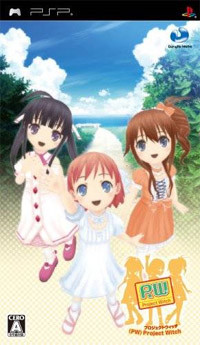 Developer: GungHo
Developer: GungHo
Publisher: GungHo
Platform: PSP
Players: 1-2 (ad-hoc, in the fighting mini-game)
It's sad commentary on modern anime and games when I can't tell if something is targeted at young girls or 25-year-old men who like young girls in often disquieting ways. One such game is (PW) Project Witch from GungHo Works, the developer behind the upcoming Lunar PSP remake. It seems innocent and harmless, with an “A” rating and lots of dress-up games for its polygonal witch heroines. On the other hand, the game shipped in three special collectors' editions, one for each character, and a promotional video shows the witches dancing around in cat ears. What's more, it's on the PSP, which isn't really the system of choice among kids' games. Perhaps, in an age where Pretty Cure courts both small girls and broken older men, there's no point in dithering over what's aimed at who. Project Witch is a lightweight little simulation game where the player directs one of three witches (Shell, Lilte, and Marl) through a summer of over 300 different scenes. That's apparently not counting the mini-games, which span dance-offs, house decorating, and brawls that resemble a side-view fighting game. Because a witch's education isn't complete without fisticuffs.
Chances for a Domestic Release: Slim at best.
RELEASES FOR THE WEEK OF 8-2
SPACE BUST-A-MOVE Developer: Taito
Developer: Taito Publisher: Taito/Square Enix Platform: DS Players: 1-4 (Wi-Fi) MSRP: 19.99 There's nothing of interest shipping next week, but you can always check out Space Bust-A-Move as early as this week. The outer-space setting is mostly for show here, since the game has the same puzzle mechanics as it did over a decade ago: fire bubbles from below, linking them with bubbles of similar colors while your ultra-cute avatar squeals in triumph. It's well-suited to the DS screen, and like all Bust-A-Move games, it'll draw in all sorts of people who shun your Street Fighters and Half-Lifes. Space Bust-A-Move also offers boss battles, multiplayer, and a bunch of squat, wide-eyed characters headed by the Bubble Bobble dragons (or are they dinosaurs?) Bob and Bub. Thankfully, Space Bust-A-Move makes them look much cuter than the bloated monstrosities they were on the cover of Bubble Bobble Revolution. Also Shipping: A bunch of G.I. Joe: The Rise of Cobra games.
|
EXTRA LIVES: CYBORG HUNTER
 I have no doubt that there's at least one huge Sonic Soldier Borgman fan out there, one who owns the 1988 TV series and its follow-ups on VHS, laserdisc, and any other available formats. That fan will not be pleased when I dismiss the series as yet another mechanized superhero anime of the 1980s and skip to explaining just how a Borgman game became Cyborg Hunter for the Sega Master System. Such is the prerogative of a column about video games.
I have no doubt that there's at least one huge Sonic Soldier Borgman fan out there, one who owns the 1988 TV series and its follow-ups on VHS, laserdisc, and any other available formats. That fan will not be pleased when I dismiss the series as yet another mechanized superhero anime of the 1980s and skip to explaining just how a Borgman game became Cyborg Hunter for the Sega Master System. Such is the prerogative of a column about video games.
Sega couldn't really afford to waste any promising Master System games in 1988, so when Sonic Soldier Borgman inspired a not-unimpressive side-scroller, the game was swiftly repackaged as the royalties-free Cyborg Hunter. Very little was changed beyond a few names. While main character Ryo Hibiki is now “Paladin,” his cybernetically armored sprite is undoctored as he jogs and punches through a mass of androids and mutants. The only major alteration dealt with Ryo's requisite hint-spouting supervisor, who went from a bespectacled brunette to an Americanized, vintage-1988 blonde news anchor.
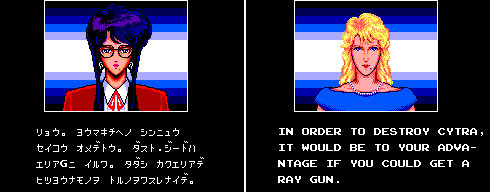
In Ryo's trek through sleek corridors, Cyborg Hunter strongly resembles Zillion, another Master System game with anime ties (which weren't yanked for American audiences). It doesn't span the same Metroid-style labyrinth, but Cyborg Hunter adopts a limited non-linear approach. Paladin combs multi-level buildings for items and power-ups, and he's free to enter any of three mazes at a time, though he's stuck there until he's defeated every major cyborg and found some specific item.
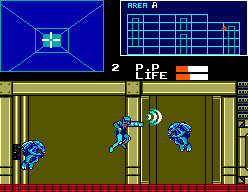 Instead of employing the entire screen for action, Cyborg Hunter fills up half of it with a map, a life meter, a Psycho Power meter (unwisely abbreviated as “P.P.”) and a radar display that bleeps whenever Paladin's near a heavy-hitting enemy. Surprisingly, it all works. The map keeps you from getting lost in the often identical hallways, and the radar screen prevents any unexpected attacks by enemies, most of whom are too dumb to strike all at once. Paladin prepares for them by upgrading his arsenal with hover packs and lasers, while his more effective attacks drain Psycho Power.
Instead of employing the entire screen for action, Cyborg Hunter fills up half of it with a map, a life meter, a Psycho Power meter (unwisely abbreviated as “P.P.”) and a radar display that bleeps whenever Paladin's near a heavy-hitting enemy. Surprisingly, it all works. The map keeps you from getting lost in the often identical hallways, and the radar screen prevents any unexpected attacks by enemies, most of whom are too dumb to strike all at once. Paladin prepares for them by upgrading his arsenal with hover packs and lasers, while his more effective attacks drain Psycho Power.
Cyborg Hunter's sound effects are average and its visuals pedestrian, but the game holds together quite well for something drawn from anime. The mazes are repetitive, yet they're relatively easy to navigate, and each is stocked with new enemies, forcing the player to adapt to different sub-bosses and pawn foes. The control is relatively loose, though the rock-stupid enemies are normally easy to trap into patterns. It's even challenging in a relatively fair way. The continues are limited but forgiving, as they let you retain all of the victories and items you've saved up.
 The most unpleasant part of Cyborg Hunter involves the Master System itself. As can be verified by any kid whose well-meaning parents bought the superior-on-paper console, the earlier Master System has only a d-pad and two action buttons on its controller. The pause button is on the console itself, and this creates some odd arrangements in games. Cyborg Hunter still uses the system-mounted pause button, but it also brings in the second controller whenever you want to call up Paladin's menu screen. Perhaps the game was hemmed in by the Master System's controller design, but using two controllers for a simple side-scroller is just strange.
The most unpleasant part of Cyborg Hunter involves the Master System itself. As can be verified by any kid whose well-meaning parents bought the superior-on-paper console, the earlier Master System has only a d-pad and two action buttons on its controller. The pause button is on the console itself, and this creates some odd arrangements in games. Cyborg Hunter still uses the system-mounted pause button, but it also brings in the second controller whenever you want to call up Paladin's menu screen. Perhaps the game was hemmed in by the Master System's controller design, but using two controllers for a simple side-scroller is just strange.
Cyborg Hunter falls shy of the best Master System games, but it's a solid treatment of an anime license, which Sega often handled with more care than Bandai or other cartoon-driven companies. Of course, that license was stripped out of a game that didn't really make too much of it in terms of plot, but that might be the appeal of it. Anime-related or not, Cyborg Hunter's not bad at all.
Cyborg Hunter is fairly cheap on the second-hand market, and even a complete copy is easy to find (believe it or not, the box art's good compared to other Master System titles). The Japanese version is considerably rarer.
discuss this in the forum (17 posts) |
this article has been modified since it was originally posted; see change history